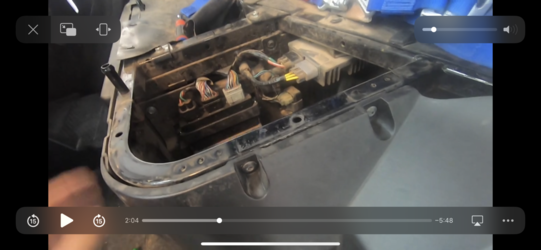Having trouble that I posted yesterday about starting and dying. Upon inspection, The 2 pronged box under the seat has oil leaking from it. I unplugged the connector closest to the door and and it was wet with oil. The box is directly under the seat. Not the 3 plug ECU. The 2 plug box under the driver left but cheek. I think there is oil in it to keep it cool not sure though. What does the box control?
You are using an out of date browser. It may not display this or other websites correctly.
You should upgrade or use an alternative browser.
You should upgrade or use an alternative browser.
Adam490
HFA Grand High Wizard
Lifetime Member
Supporting Member
Can you post a picture of what you are referring to?Having trouble that I posted yesterday about starting and dying. Upon inspection, The 2 pronged box under the seat has oil leaking from it. I unplugged the connector closest to the door and and it was wet with oil. The box is directly under the seat. Not the 3 plug ECU. The 2 plug box under the driver left but cheek. I think there is oil in it to keep it cool not sure though. What does the box control?
The machine in in my dads garage (heated) about an hour away all taken apart. I left it there after replacing all IACV and the injector wires was not the fix. I had to take the top of the under seat storage box off then noticed the oily connector. Maybe someone else will know what it controls.
tjoreo
Well-Known Member
Lifetime Member
tjoreo
Well-Known Member
Lifetime Member
That might explain the voltage changes and spikes. I believe in another thread you spoke about 11 to 12 volts. When my bike is running it is running a constant 14.2 volts. When you are lowering your RPM's it might be getting to low of voltage for the unit.
JenElio
NTC's NoMo Chupacabra Caliente!!....
Lifetime Member
Someone else was having a similar issue with oil in the plug not too long ago. For the life of me I can't remember the thread or what the cause/fix was, sorry. Hopefully someone will chime in soon.
@HondaTech might know, hi's one of the gurus around here
Oops. Asked that question before I saw your answer. Thanks JenElio
advertisement
Wallace
Well that didn't go as planned
Lifetime Member
The thread is "What is this???".Someone else was having a similar issue with oil in the plug not too long ago. For the life of me I can't remember the thread or what the cause/fix was, sorry. Hopefully someone will chime in soon.
@HondaTech might know, hi's one of the gurus around here
This is from an Africa twin site.....
The immediate and naive thought that immediately comes to mind is:
Alternative thought:
The immediate and naive thought that immediately comes to mind is:
- Access the source end of the cable.
- Detach and clean-up the end.
- Solder the affected braided wire so to stop the wicking effect up into the conductor strands.
- Follow this up by an application of heat-resistant epoxy around the conductor sheath end and the wire itself. This prevents oil from getting between the sheath and conductor, bypassing the soldered braided fix and resume the wicking behaviour along the remaining length of the cable.
Alternative thought:
- Strip away about 1/4 to 1/2 inch of sheath not far from the source connector.
- Solder the conductor so all braided strands are bonded.
- Dip the entire 1/4 to 1/2 inch unsheathed area in heat-resistance (oil resistant) epoxy.
- Consider wrapping the section in electrical tape or similar protection.
WagginTail
Well-Known Member
Lifetime Member
Club Contributor
Yea I remember seeing that thread also. Can't remember whereSomeone else was having a similar issue with oil in the plug not too long ago. For the life of me I can't remember the thread or what the cause/fix was, sorry. Hopefully someone will chime in soon.
@HondaTech might know, hi's one of the gurus around here
Similar threads
T
- Replies
- 10
- Views
- 345


